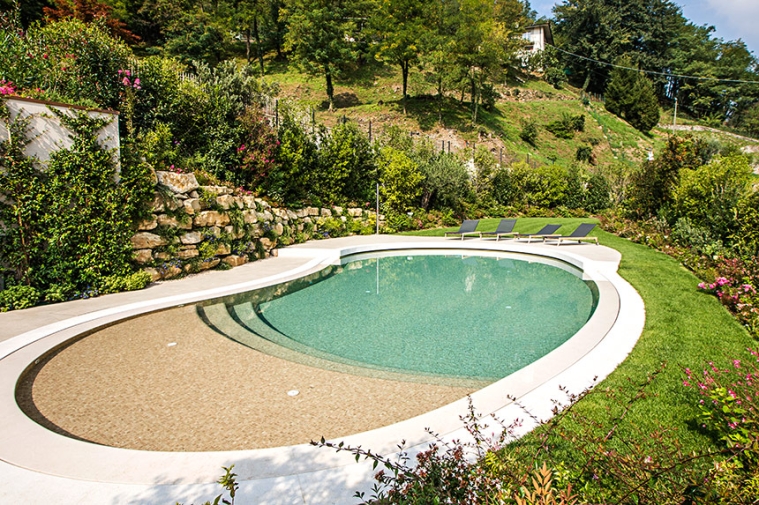Pool tiling
Choosing the right tiling for your pool can be complicated. In the next few lines, we´ll try to clear up some of your doubts.
Swimming pools have become an important part of landscaping. They´re no longer thought of as an element developed independently, but rather as an integrated part of outdoor architecture.

The choice of pool tiling will be fundamental for achieving the desired result.
Below we´ll discuss the types of pool cladding available on the market, together with their advantages and drawbacks:
1. Glass mosaic tiles
Advantages of glass mosaic tiles
This is the most popular type of pool surface used in Spain. The main advantages are its exceptional resilience, long lifespan, and virtually limitless choice of colours and textures, including designs that imitate natural stone, marble, and wood.
Drawbacks of glass mosaic tiles
One thing to consider of this type of pool tiling is that if tiles are joined with a cement-based grout, the pool will need to be regrouted every 5 to 6 years, as chemicals added to the pool water tend to degrade cement-based grouts. This is why ezarri recommends the more resistant epoxy grout. To prevent mosaic tiles from detaching, ezarri recommends using C2S1 adhesive.

2. Liner
PVC pool liners are also used for surfacing pools. PVC liners are widely used in much of Europe although less so in Spain.
Benefits of PVC pool liners
The main advantage of PVC lining is that it creates an effective water seal and prevents cracking issues. It is also a less expensive option.
Disadvantages of PVC pool liners
The main drawback is fading and discoloration, which means it must be replaced every 4 to 5 years. Another disadvantage is a more synthetic, less natural feel.
3. Paint
Advantages of painting
Painting is an inexpensive pool surfacing solution and is very easy to apply.
Drawbacks of painting
The main drawback of this type of pool cladding is maintenance. Painted pool surfaces are not very resilient to sun and chemical exposure and should therefore be repainted every year.
4. Porcelain
Benefits of porcelain ceramics
The advantages of porcelain ceramics are its resilience and the range of brands and colours available (although less variety than mosaic).
Disadvantages of porcelain ceramics
The main drawback of this pool cladding is its high cost and complicated installation. Another disadvantage is that it is harder to adapt larger formats to irregular pool shapes.
EZARRI, S.A. como responsable del tratamiento, le informa que sus datos son recabados con la finalidad de contactar con el solicitante, atender sus consultas y peticiones y para envío de ofertas e información relacionada siempre con nuestra actividad. La base legal para el tratamiento de sus datos es el consentimiento del interesado al contactar con nuestra organización. Sus datos no se cederán a terceros salvo obligación legal. Cualquier persona tiene derecho a solicitar el acceso, rectificación, supresión, limitación del tratamiento, oposición o derecho a la portabilidad de sus datos personales, escribiéndonos a nuestra dirección arriba indicada, o enviando un correo electrónico a info@ezarri.com, indicando el derecho que desea ejercer. Puede obtener información adicional aquí.



